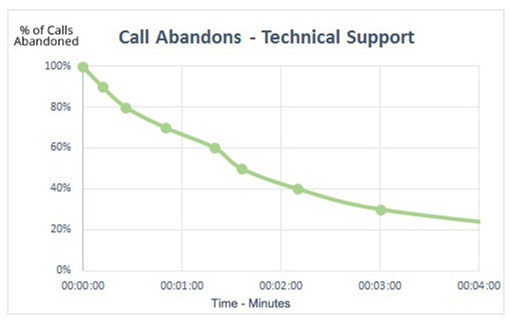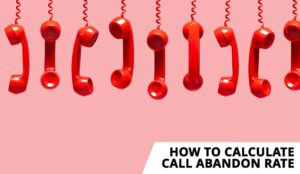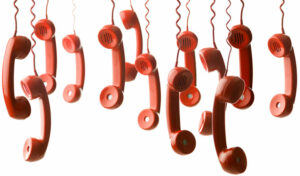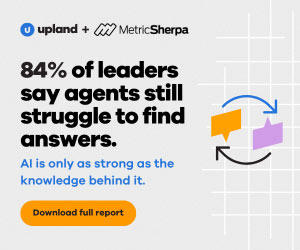In a contact centre, not every unanswered call is the same, and understanding the difference matters. When a call doesn’t reach an advisor, was the call abandoned, missed, or simply lost?
While these terms are often used interchangeably, each one points to a different issue in the call-handling process.
Whether it’s a customer deciding not to wait, a call dropped due to a technical fault, or a call ended by the contact centre itself, the reason behind the disconnect affects how it should be recorded and resolved.
In this article, we break down the distinctions between abandoned, missed, and lost calls, explain how they’re tracked, and explore what they reveal about the customer experience.
Types of Unanswered Calls
To clarify the difference between types of unanswered calls, here are some simple definitions for each:
What is an Abandoned Call?
An abandoned call occurs when a customer initiates contact with a call centre but disconnects before reaching an agent.
This can happen if the caller hangs up while waiting in a queue due to long wait times or dissatisfaction with the hold experience.
For advice on calculating Call Abandon Rate in the contact centre, read our article: How to Measure Call Abandon Rate
What is a Missed Call?
A missed call refers to an inbound call that is not answered by any agent or automated system.
The call may go unanswered due to agents being unavailable, the call centre being closed, or calls that are deliberately disconnected by the contact centre (this is rare but can happen when the call reaches the maximum wait time that’s set by the ACD system).
In outbound, a “missed call” refers to a call that reaches the customer’s answerphone.
What is a Dropped Call?
A dropped call refers to an unintentional disconnection of a call, typically caused by technical issues such as poor network coverage, system failures, or hardware malfunctions, rather than the caller or agent deliberately ending the interaction.
This can occur at any point during the call, including while waiting in a queue or during the conversation with an agent.
Network connectivity issues increase dropped calls. These are more prevalent within remote contact centre environments, as poor advisor WiFi can be a key cause.
A dropped call rate of even one or two percent should set alarm bells ringing.
What is a Lost Call?
Lost Calls refer to any call that fails to reach an advisor.
Abandoned, dropped, and missed calls are all types of lost calls.
How to Track Abandoned, Missed and Lost Calls
Check Definitions Match Up With the ACD System
Lost calls are generally detected, recorded and tracked within the ACD system. This is useful data for forecasting and scheduling.
So, make sure that the ACD system’s definition of each matches the contact centre’s. Having one version of the truth is crucial.
“If you’re taking any metric from an automated report, check the system’s definition and understand what it tells you,” says John Casey, a resource planning expert at CCplanning.
“For example, some telephony systems have three different triggers to calculate abandon rates. These report different rates, as they start reporting abandons at different periods.”
So, don’t take the definitions above as gospel. Although it is how most planners would define each type of lost call, it’s not always the case. So ensure everyone in the planning team understands how every metric is measured.
Use ACD System Reports
ACD systems produce call abandon reports. These enable contact centres to keep tabs on lost calls in real time and historically, with lots of insights into abandoned calls especially.
Call abandon reports from the ACD system will share information across various call queues.
For example, contact centres can often capture:
- The percentage abandon rate across the day
- The average time to abandon
- The longest customer wait time before abandon
Synchronize Telephony Software and WFM Systems
Sometimes the telephony software doesn’t synchronize with the mapping of the workforce management (WFM) system.
The problem here is that the telephony system may record a call as abandoned or missed in one interval, but the WFM records it as belonging to the next.
In this scenario, the telephony system would place the lost call within the interval it first entered the queue. The WFM system would place it within the interval that it was lost.
According to Doug Casterton, Head of Operational Excellence at Get Your Guide, this problem has stumped many planning professionals, playing havoc with the forecasting process.
“A lot of people struggle to come to terms with why their abandon rate is so bad in a certain interval, as they may have perfectly staffed that period. Yet it’s often because the contact started in the previous interval,” – Doug.
So, be aware of this problem and consider whether it is influencing lost call rates.
Finally, to track dropped calls, ACD systems may not provide the right insights. Number testing software can help here to constantly check for connectivity errors.
X Ways to Reduce Lost Calls
Reducing lost calls means that more customers get the answers they seek. Here’s how contact centres can do so while increasing customer satisfaction and retention in the process.
1. Improve Staffing
Easy to say, difficult to do. But, by building better forecasts and schedules, contact centres can more accurately meet incoming demand and avoid customers hanging up.
Let’s take a look at a few quick tips for how to do just that, starting with forecasting:
- Experiment with numerous forecasting models, using old data to do so. This will provide an indication as to how well the model is suited to the contact centre environment.
- Analyse the outliers that are being removed to improve future forecasts. By doing so, the contact centre can be sure that it’s really an outlier and that it’s not becoming a business-as-usual pattern.
- Reforecast a day in the contact centre a couple of days before it is worked. This ensures that staffing plans are as accurate as when they were first made.
Here’re a few more tips for improving scheduling practices:
- Measure schedule inflexibility regularly. Acting as a buffer, this helps to ensure that schedules can be better created to meet incoming demand.
- Understand when calls are likely to flood in, whether that’s just after the hour mark or just before. In doing so, contact centres can better plan breaks, coaching sessions and meetings.
- Share the difficulties of creating schedules with advisors, so they know what to expect before shifts are published. This will help them to appreciate the hard work that goes into schedules, making advisors more likely to stick to them.
If you are looking for lots more top tips for forecasting and scheduling, read our article: 50 Expert Tips to Improve Contact Centre WFM
2. Bolster On-Hold Messaging
Present on-hold messages in order of importance to the customer. The more important the message, the more it will keep the customer engaged.
Not-so-important messages will include those that involve cross-selling. Doug Casterton warns that these might be frustrating customers, making them more likely to hang up.
“Many contact centres will try cross-selling in the queue, which I’m really not a fan of – especially when that message repeats itself,” says Doug.
“You might get away with one or two messages, if it’s particularly interesting to the customer. But be careful. Even an apology can become irritating if it is repeated over time.”
A good tip here is to research after which message customers tend to abandon. Other tips for creating better on-hold messages include:
- Analyse the most effective music-to-message ratio.
- Include messages that tell customers how long they have left to queue.
- Revisit old messages to check for accuracy.
3. Offer a Choice of Hold Music
Understanding the demographic of customers and choosing hold music that’s suited to them will likely encourage customers to stay on the line longer.
“Generally, melodic non-heavy music helps,” says John Casey. “However, there is research that suggests that giving customers a choice of music to listen to encourages them to wait longer.”
Now, if customers are only waiting 20 seconds, this may not be the best course of action, as it increases customer effort. But for longer queues, this could help to reduce call abandons.
For a bit more information on hold music, read our article: What Customers Really Think of Music on Hold
4. Streamline the IVR
“If a contact centre has an IVR with multiple layers, the customer might spend ten minutes trying to navigate the system. Ten minutes in the IVR plus ten minutes in the call queue is effectively 20 minutes of waiting,” says Doug.
So, if you simplify the IVR, customers will likely have more patience when they enter the queue. This will stop them from abandoning early and also greatly reduce frustration.
5. Check Advisors’ Internet Speeds
Dropped calls are often a result of network connectivity problems. When working in a remote contact centre environment, dropped calls are more common.
So, run internet speed checks with work-from-home (WFM) advisors. Also, offer them Wi-Fi boosters to increase speeds, and build a requirement for good internet into the contact centre’s homeworking policy.
6. Callbacks – But Be Careful!
Callback technology reserves the customer’s place in the call queue. This can drastically reduce abandon rates, but it comes with a warning label.
“If you have a very clear spike in traffic, callback technology is fine, but if you’re experiencing a long-term increase in demand that wasn’t forecasted, it doesn’t work so well,” says John.
“In my current contact centre, Tuesday is the busiest day. After Bank Holiday Monday, I know it’s going to be especially busy. There won’t be a lull, so I need a proper WFM solution, not callbacks.”
The reason why callbacks don’t work in such a scenario is that advisors have to physically phone them back, making the queue – virtual though it may be – longer than it was previously.
7. Report Short Abandons Separately
Some contact centres will remove short calls from their measurement of abandon rate, which can help to make abandon rates look better, but does have its downsides.
“Short abandon calls are an indication of technical problems,” James Barnes, Director of Consulting at Destructive Digital.
“Of course, sometimes customers may be interrupted by something within their life or have realized they’ve joined the wrong IVR queue and abandon quickly. But it’s good to at least track short abandons separately.”
If there is then a trend in short abandoned calls, that might indicate an increase in dropped calls due to technical error. By looking into this, contact centres can potentially spot and put an end to a problem before it snowballs.
8. Use Abandon Rates to Inform Service Levels
By plotting abandon rates against time in queue, contact centres can create call abandon curves. These results will enable the contact centre to set service levels against customer patience.
Here’s an example of one customer abandon curve:

Using such a graph, the contact centre can set an “abandon ceiling”. This will stipulate the maximum percentage of abandons deemed acceptable, which will likely be between 2 and 10%. The percentage chosen will then guide the service level.
From this, contact centres may set different cost-effective service levels for different query types. Yet, as James Barnes tells us, it just depends on what customers do.
James says: “It’s important to assess your environment and consider at what point do customers look somewhere else? Or at what point do they open up a new channel, we can’t cope and it costs us more to serve?”
For more on the relationship between these two metrics, read our article: How to Predict Call Abandon Rates Based on Service Level
9. Reconsider Opening Hours
“If abandon rates are high early in the day, would opening half an hour earlier help? This is worth considering, as for a certain percentage of these calls the customer will have tried to call before the contact centre opened,” says John.
On the other hand, if abandon rates peak in the middle of the day, rethink lunch breaks and consider offering more part-time shifts to cover peaks.
When abandon rates are high throughout the day, that indicates a problem within staffing calculations or advisor behaviours.
Uncover more expert advice on managing abandoned calls in our articles:
- How to Bring Down Your Call-Abandon Rates
- 50 MORE Expert Tips to Improve Contact Centre WFM
- Which KPIs Do I Need for Contact Centre WFM?
Author: Charlie Mitchell
Reviewed by: Megan Jones
Published On: 15th Dec 2021 - Last modified: 18th Aug 2025
Read more about - Call Centre Management, Abandoned Calls, Call Handling, Charlie Mitchell, Customer Service, Doug Casterton, Editor's Picks, John Casey, Management Strategies










































